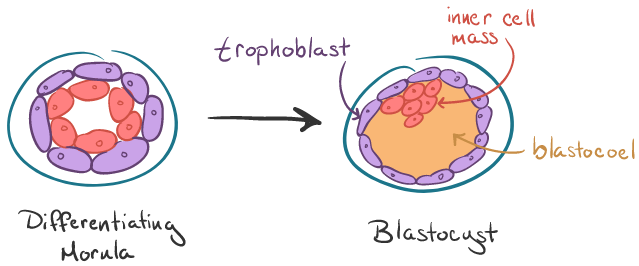Guide to IVF Embryo Grading

Originally published 03/20/21. Updated for accuracy and relevancy on 02/18/2024
Is a 5AA a “good” embryo? What about 4AB? These embryo gradings may sound cryptic, and we’re here to help you understand all things embryo grading and success rates.
If you are going through in vitro fertilization (IVF), you may have received an embryo report outlining the "grades" of your embryo(s). While an embryo grading chart is a useful tool for embryologists to use, the grades can be difficult to decipher. So, we've written this guide to walk you through how embryologists come up with this grade and what it means for your chances of success.
How Are IVF Embryos Graded?
The embryo grade system is an important step of the IVF Funnel and looks at the development in two stages. The day 3 embryo, also known as the “cleavage stage” embryo, looks at the number of cells and their structure. Day 5 stage looks at the blastocyst stage.
The Gardner Embryo/Blastocyst Grading System is a common way embryologists grade embryos quality to determine embryo development and ultimately potential for success. The system has three parts, a letter and two numbers (e.g. 4AA, 2BA, 5AB). Let's walk through each part:
- Blastocyst development stage: 1 – 6 (with 5 being the most developed)
- ICM quality: A – C (A being the best)
- TE Quality: A – C (A being the best)
The Number
Let's start with the number, 1-6. This number indicates the blastocyst development stage or the degree of the expansion of the embryo's cavity.1
- 1: Early blastocyst—the blastocele is less than half the volume of the embryo.
- 2: Blastocyst—the blastocele is greater than or equal to half of the volume of the embryo.
- 3: Full blastocyst—the blastocele completely fills the embryo.
- 4: Expanded blastocyst—the blastocele volume is larger than that of the early embryo and the zona pellucida is thinning.
- 5: Hatching blastocyst—the trophectoderm has started to herniate through zona pellucida.
- 6: Hatched blastocyst—the blastocyst has completely escaped from the zona pellucida.
The Letter
After the number comes two letters. These letters are for the two parts of a day-5 embryo (also called a blastocyst):
- The Inner Cell Mass (ICM), which becomes the fetus
- The Trophectoderm (TE), which becomes the placenta and other essential tissues

Image from Khan Academy
These two cell types make a microscopic, fluid-filled sphere with the TE cells on the outside and the ICM inside. Both of these cell types are important because you need both a fetus and placenta for a healthy pregnancy.
For the IMC letter grade, A is the highest grading which means the embryologist observed numerous cells, tightly packed. B means there were several cells tightly packed. And C indicates very few cells.
Blastocyst embryo grading is helpful. However, the potential of the embryo to implant and lead to a healthy baby is difficult to predict using grading alone. Most clinics will combine this data with PGT-A genetic testing, which looks at an embryo’s chromosomal status. Together, these two data points can help with embryo selection for the best chance of success for you.
Embryo Success Rates by Morphology Grading
A 2018 study looking at 914 single IVF transfers (of genetically “normal” embryos) found that blastocyst quality does correlate with pregnancy outcomes.2 However, we don’t all have loads of “excellent” or grade A embryos to choose from, so it’s important to work with your doctor to understand your chances of success and the best path forward so that you only see positive signs after embryo transfer.
“Excellent” Grading
Embryos categorized as “excellent” had a 65% pregnancy rate and 50% live birth rate.
Embryos in this category include:
- 3AA
- 4AA
- 5AA
- 6AA
“Good” Grading
Embryos categorized as “good” had a 59.3% pregnancy rate and 49.7% live birth rate.
Embryos in this category include:
- 3AB
- 4AB
- 5AB
- 6AB
- 4BA
- 5BA
- 6BA
“Average” Grading
Embryos categorized as “average” had a 50.3% pregnancy rate and 42.3% live birth rate. Embryos in this category include:
- 3BB
- 4BB
- 5BB
- 6BB
“Poor” Grading
Embryos categorized as “poor” had a 33.3% pregnancy rate and 25% live birth rate.
Embryos rated “poor” include:
- 4BC
- 5BC
- 6BC
- 4CB
- 5CB
- 6CB
A Cornell study found blastocyst grading of embryos and particularly inner cell mass grade (the first letter) is a useful predictor of a successful pregnancy.2 The outcomes in this study were even better than the previous one.2 Among 477 euploids (genetically "normal") embryos:
- “Excellent” embryos had an 84.2% chance of ongoing pregnancy
- “Good” embryos had a 61.8% chance of ongoing pregnancy
- “Average” embryos had a 55.8% chance of ongoing pregnancy
- “Poor” embryos had a 35.8% chance of ongoing pregnancy
This study did not report the live birth rate, only the chances of ongoing pregnancy (beyond 24 weeks' gestation).
What Is the Best Grade of Embryos in IVF?
Does embryo grading matter? Yes. Looking at the data, grade A embryos with AA grading (3AA, 4AA, 5AA, 6AA) have the best chances of success. Embryos graded as AB or BA (3AB, 4AB, 5AB, 6AB, 3BA, 4BA, 5BA, 6BA), seem to have a lower chance of pregnancy, but a nearly similar chance of live birth. Embryos graded as BB (3BB, 4BB, 5BB, 6BB) still have a good chance of success at 50% for pregnancy and 42.3% for live birth. While those graded BC or CB have about a third chance of successful implantation and a 25% chance of live birth.
Want to learn more about egg and embryo health? Find out what supplements can help with egg quality.
IVF can be an amazing way to grow a family. I know—I would not be a mother today without IVF. But it also comes with emotional ups and downs.
Medically reviewed by Dr. Kenosha Gleaton
Dr. Kenosha Gleaton is board-certified in gynecology and obstetrics and is the Medical Advisor of Natalist. She received her MD from MUSC and completed her residency at Carolinas Medical Center in Charlotte, NC.
p>Dr. Gleaton is passionate about women, youth, and mentoring. She is a Scrubs Camp instructor, a program to increase student entry in healthcare, and serves as a Compassion International adoptive parent. She is also a member of the American College of Obstetrics & Gynecology, the American Association of Gynecologic Laparoscopists, and the American Association of Professional Women.
Sources:
- Machtinger R, Racowsky C. Morphological systems of human embryo assessment and clinical evidence. Reproductive BioMedicine Online. 2013;26(3):210-221. doi:https://doi.org/10.1016/j.rbmo.2012.10.021
- Irani M, Reichman D, Robles A, et al. Morphologic grading of euploid blastocysts influences implantation and ongoing pregnancy rates. Fertility and Sterility. 2017;107(3):664-670. doi:https://doi.org/10.1016/j.fertnstert.2016.11.012
Reach Out, We're Here
Have questions about your order or products? For the speediest answer, check out our FAQ section. Need something else? Come find us below.
Please keep in mind our regular business hours; Monday-Friday, 9am-5pm CT.
Customer Support
support@natalist.com
Press Inquiries
media@everlyhealth.com
Business & Partnerships
team@natalist.com
Affiliates + Influencers
team@natalist.com
Job Openings
Careers Page
























